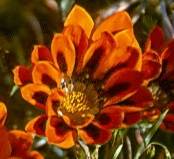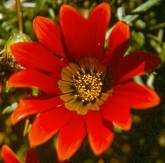Gazania krebsiana
Gazania krebsiana Less.
Family: Asteraceae
Common names: terracotta gazania (Eng.); gousblom, botterblom, rooi gazania (Afr.)
Introduction
Gazania krebsiana, previously known as Gazania pavonia, must be one of Namaqualand 's most well-known and striking perennial plants. This flamboyant, variable and versatile plant is the trademark of the unique country landscapes in Namaqualand (the wild flower region in South Africa's western extremities) and the pride of the flower route in South Africa.

Description
Description
Gazania krebsiana is an extremely showy plant when in flower, largely due to its warm and bright flower colour, its flower size, and its extended flowering period. The plants are semi-decumbent (prostrate to ascending), perennial and herbaceous, and reach a height of approximately 150 mm. They are therefore aptly referred to as tufted groundcovers, and many individuals together may give a rather mat-like appearance, a sight that is very beautiful when in bloom. Individually they form rounded tufts on the ground of about 200 mm across with very distinctive foliage. The root system of G. krebsiana is fairly weak and consists of a series of adventitious roots. There is no definite main or taproot meaning the adventitious roots are quite shallow, only about 250 mm deep. This is one of the reasons why these plants react so well to rain and are therefore regarded as excellent pioneer plants.

The leaves may vary in shape especially when young. Mature leaves are usually compound and divided into small, narrow, regular lobes of about 4-6 on each side. They are rough to the touch, dark shiny green on the upper side and woolly white underneath. The main vein is brownish and prominent on the underside. The leaf, including the petiole (leafstalk), can reach a length of 170 mm. Leaves are closely spaced on the short shoots. A distinctive characteristic of Gazania is that the flowering stalks contain a milky sap.
Flowerheads measure 50-60(-90) mm in diameter. The upper side of the ray florets (the florets at the margin of a flowerhead in the Asteraceae) is mainly a magnificent dark red or orange, with dark brown markings on the lower quarter. In some literature the flower colour is referred to as terracotta, hence the common name terracotta gazania. The dark brown markings may contain black or white spots, adding more eloquence to the flowers. Gazania krebsiana flowers from August till January, reaching a peak in October and November.


Each flowerhead contains about 25 fruits, ± 5 x 1 mm. Each fruit is equipped with silky hairs that enable it to be easily dispersed by the wind. The seeds start maturing from October, and ants may be seen carrying them away into their underground tunnels.
Conservation Status
Status
Due to its adaptability and the abundance of seeds it produces, Gazania krebsiana is well established in all habitats across its distribution range. Seeds are able to travel across large distances and can remain viable for a number of years. The plants are relatively short-lived, up to about three years depending on various conditions. Currently there is no concern that these plants might become rare or endangered. However, it must be mentioned that many major populations in certain parts of Namaqualand have become heavily reduced, largely due to overgrazing from domestic livestock.
Distribution and habitat
Distribution description
Gazania krebsiana has a very wide distribution range, mainly within the winter rainfall region of South Africa. It is found in virtually all provinces of South Africa from Namaqualand in the west to the Eastern Cape and KwaZulu-Natal in the east. Northward it extends into the drier interior of the Great Karoo, the Free State and then into some parts of the summer rainfall regions of Gauteng and the Lowveld. Plants are adaptable and flourish in a host of habitats but are mostly found along roadsides, on flats or lower slopes, exposed hills and rocky outcrops and stony ridges. The latter two habitats are especially ideal in the Namaqualand region of the country. To a lesser extent they may well be found in grassy situations, in montane vegetation, and in coastal dune vegetation which is commonly referred to as Strandveld (seaside plants) in the west to south, and thicket in the east. Associated vegetation types include Succulent Karoo, Nama Karoo, Fynbos, Dry Valley Bushveld and Grasslands. Plants seem to tolerate a number of soil types but have a noticeable preference for clay and sandy soil.

Derivation of name and historical aspects
History
The genus name Gazania was given in honour of Theodor of Gaza (1938-1948). He was responsible for the translation of the botanical works of Theophrastus from Greek into Latin. Another possibility is that gaza (Greek for riches) could refer to the richness in colour, variety and abundance of the plant. The Afrikaans common name botterblom (butter flower) owes its name to the fact that the ray florets are supposed to taste like butter when chewed. The English common name, terracotta gazania, refers to the terracotta colour of the flowers.
Ecology
Ecology
Gazania krebsiana is one of those plants that adapts extremely quickly to its environment and is therefore able to survive and multiply easily compared to other plants. In the very dry summer months the plants shrivel, and all that is visible are a few very dry, curly leaves. Under these conditions the plant may look dead to the observer, but in fact it is minimising its exposure to the hot sun and saving water loss through its leaves. The woolly underside of the leaves often points upwards and in so doing may help cool the plant down a little. As soon as the rain arrives, plants respond rapidly and the whole plant body swells up and becomes a lush green in colour, with erect leaves and the formation of flowerbuds.
Time is crucial for these colourful plants, and they have to maximise every opportunity to become as visible as possible so that pollination and the dispersal of seeds can take place. This is why they are one of the most successful survivors of the Asteraceae. Gazania krebsiana is pollinated by a number of insects: bees, bee flies, beetles, butterflies and ants have all been seen visiting its bright flowers. This is another reason why they are able to thrive in most environments, as they do not have any specific pollinators. Monkey beetles are more or less endemic to the winter rainfall region of South Africa. They are essentially pollen feeders, and many species are gregarious, congregating in flowers to feed and mate. The markings at the base of the petals of G. krebsiana show a striking resemblance to monkey beetles. This appearance of a busy singles' bar may well act as an attraction to passing males in search of females. The brown monkey beetle (Pachycnema marginella) often meets and mates on the flowers of G. krebsiana. Each flower head contains about 25 fruits, each provided with silky hairs, which facilitate dispersal by the wind. Ants also play a role in the dispersal of seeds, and have been observed carrying seeds underground.
Seeds germinate with ease at the beginning of the rainy season, which commences in April or May. The seedlings grow fast and manage with very little water. They establish their adventitious roots very close to the soil surface to utilise moisture more effectively.
Uses
Use
Gazania krebsiana are very good colonisers, and are also regarded as very good soil stabilisers. Wild and domesticated herbivores are very fond of these plants. Gazania krebsiana and other members of the genus are very valuable for grazing, but are often underestimated. The plants can make a major contribution to the pasture, especially in the dry areas of the winter rainfall region where denuded, trampled patches occur in the veld. Due to unwise subsistence farming in the Namaqualand region, many Gazania habitats were completely transformed and the plants have become absent from the land.
Apart from the fact that Gazania krebsiana is a palatable plant, there don't seem to be any recorded medicinal uses. It is a popular garden plant. it is one of the parent plants for the numerous Gazania hybrids that are offered in many nurseries today. Gazania krebsiana makes a fantastic garden plant provided it is planted in a sunny area and does not get too much water. It can be used either individually in beds, as a border plant, in mass plantings, and in window boxes or containers. The best floral displays can be achieved by planting them in masses like ground covers or by using several species of Gazania together. There are a number of Gazania subspecies, cultivars, and hybrids available from nurseries, each with its own unique character and colour.
Annual plants that really complement the terracotta gazania well include plants such as Ursinia speciosa, U. cakilefolia, Dimorphotheca pluvialis, D. sinuata, Arctotis hirsuta, Felicia heterophyllo, F. dubia, Senecio elegans, and S. arenarius. Other perennials are Arctotis stoechadifolia, A. aspera, Felicia ameloides, Osteospermum fruticosum, Scabiosa incisa, Lobelia valida and Geranium incanum. The more shrub-like plants that are ideal companion plants are the strikingly colourful cushion succulents such as Lampranthus multiradiatus, L. aureus, Ruschia caroli, Drosanthemum speciosum, D. Floribundum and D. striatum. All these species flower more or less at the same time. For smaller gardens these plants can be grown in shallow rectangular containers or amongst rocks in a sunny rockery. It is also very rewarding using different species of Gazania such as G. lichtensteinii, G. rigida, and some of the common varieties such as G. rigens var. leucolaena and var. rigens. It might not even be necessary to plant them out each year, as they are able to sow themselves and appear spontaneously each year.
Growing Gazania krebsiana
Grow
All Gazania species and cultivars are easy to establish by mixing the hairy fruits with sand to obtain a better distribution and planting them directly in loosened soil. After sowing, the soil must be irrigated immediately to ensure that the seeds come in close contact with the soil for germination purposes. The seeds germinate after 4-6 days. Alternatively, sow fruits first into a sandy medium and cover slightly with sand to a depth of 2 mm. Water daily using a fine water spray and keep in a sheltered environment. As soon as the seedlings are strong enough, they may be planted in the garden. The seeds are sown in April.
References
- Eliovson, S. 1960. South African wild flowers for the garden. Howard Timmins, Cape Town.
- Germishuizen, G. & Meyer, N.L. (eds). 2003. Plants of southern Africa : an annotated checklist. Strelitzia 14. National Botanical Institute, Pretoria.
- Goldblatt, P. & Manning, J. 2000. Cape plants. A conspectus of the Cape flora of South Africa. Strelitzia 9. National Botanical Institute, Cape Town.
- Jackson, W.P.U. 1990. Origins and meanings of South African plant genera. University of Cape Town Ecolab.
- Le Roux, A. & Schelpe, E.A.C.L.E. 1997. Namaqualand. South African Wild Flower Guide 1. Botanical Society of SouthAfrica, Cape Town.
- Mason, H. 1972. Western Cape Sandveld flowers. Struik, Cape Town.
- Stearn, W.T. 2003. Stearn's dictionary of plant names for the gardener. Cassel, UK.
- Smith, C.A. 1966. Common names of South African plants. Memoirs of the Botanical Survey of South Africa No. 35.
- Van Jaarsveld, E. 2000. Water-wise indigenous gardening. Cape Town. Tafelberg.
Credits
Werner Voigt
Kirstenbosch NBG
August 2006
Plant Attributes:
Plant Type: Ground Cover, Perennial
SA Distribution: Eastern Cape, Free State, Gauteng, KwaZulu-Natal, Mpumalanga, Western Cape
Soil type: Sandy, Clay
Flowering season: Spring, Early Summer
PH: Alkaline, Neutral
Flower colour: Yellow, Orange
Aspect: Full Sun
Gardening skill: Easy
Special Features:
Horticultural zones











Rate this article
Article well written and informative
Rate this plant
Is this an interesting plant?
Login to add your Comment
Back to topNot registered yet? Click here to register.